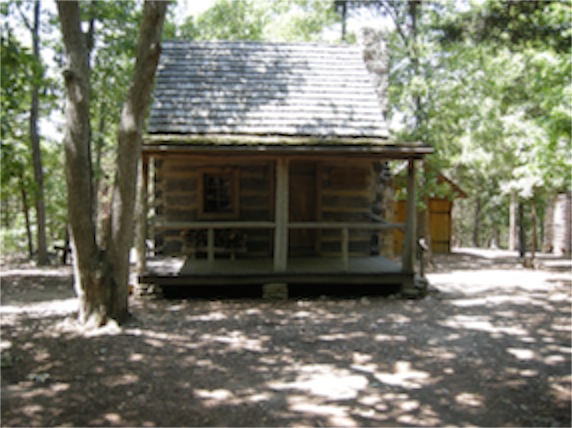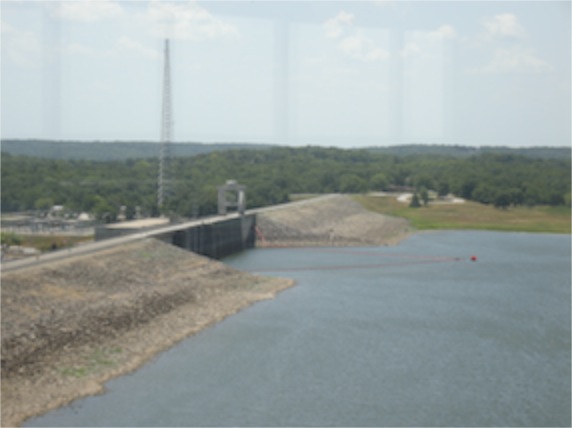Hot times in Osage Country
19/07/12 05:31
At the end of the last ice age, as the glacier receded, central Missouri became covered in spruce forest. It was home to mastodons, giant sloths, giant beavers and bears. Saber tooth cats roamed the forests and found food in smaller mammals. But the climate continued to change and the time came when it was simply too warm for the giant mammals. The spruce forests gave way to oak and elm before the first human inhabitants arrived. The Osage Indians learned to live in the hollows and they learned to anticipate the regular flooding of the rivers in the spring of each year. They knew that as nice as it was to visit the river’s edge, it wasn’t a safe place for a year-round home.
 The westward expansion of the United States brought settlers from the east who had to re-learn the ways of the rivers. They built homes along the rivers to have them flooded out and carried away by the high waters. By then the river boats were the major means of transportation, carrying wood and coal away from the region and bringing in manufactured goods. The main function of the riverboats, however, was the support of the westward expansion of the country. On the Missouri, the big boats made it as far as Fort Benton Montana, carrying goods and supplies to support the miners and settlers who were flooding into the West. On the Osage River, the boats made it up as far as Clinton and Warsaw. Supplying the boats was a big part of the life of the river towns.
The westward expansion of the United States brought settlers from the east who had to re-learn the ways of the rivers. They built homes along the rivers to have them flooded out and carried away by the high waters. By then the river boats were the major means of transportation, carrying wood and coal away from the region and bringing in manufactured goods. The main function of the riverboats, however, was the support of the westward expansion of the country. On the Missouri, the big boats made it as far as Fort Benton Montana, carrying goods and supplies to support the miners and settlers who were flooding into the West. On the Osage River, the boats made it up as far as Clinton and Warsaw. Supplying the boats was a big part of the life of the river towns.
So was flooding. The river flooded every year. Some years the floods were devastating, inundating homes and businesses and wreaking havoc in the fertile farmlands. Of course the fertility of those lands was dependent on the rich silt deposited by the floods, but when the waters rose, the farmers lost their crops.
 By the middle of the 20th Century, after the Second World War, people were able to think of big projects. There had been several successful dams built in the Tennessee Valley and Columbia River systems and a massive engineering project to provide flood control throughout the Missouri River basin and the tributaries of the Missouri was envisioned. The series of dams that were eventually built is impressive. And the lakes formed by those dams are enormous. The system works for flood control most years. Last year was an exception, when the rains came at just the wrong time as record snows melted in the high Rockies. Even with the system of dams, there was quite a bit of flooding.
By the middle of the 20th Century, after the Second World War, people were able to think of big projects. There had been several successful dams built in the Tennessee Valley and Columbia River systems and a massive engineering project to provide flood control throughout the Missouri River basin and the tributaries of the Missouri was envisioned. The series of dams that were eventually built is impressive. And the lakes formed by those dams are enormous. The system works for flood control most years. Last year was an exception, when the rains came at just the wrong time as record snows melted in the high Rockies. Even with the system of dams, there was quite a bit of flooding.
We’re camped in Harry S. Truman State Park this morning, along the shores of the giant Truman reservoir that was formed when the Osage River was dammed. Construction of the dam was begun in the early 1960’s with the completion of the dam in 1978. There are a large number of campgrounds around the lake on lands managed by the Army Corps of Engineers, the State of Missouri, and other governmental entities. The land was purchased from individual landowners in anticipation of the lake’s rise. The campgrounds are nearly empty today. I’m told that fall is the high tourist season in this region.
I’m beginning to understand why the mastodons and giant sloths abandoned this country. The high was around 104 degrees yesterday. We’re camping in a basic site, without electricity or water hookups. We spent the day outdoors yesterday, mostly seeking shade. It was even too hot to launch a rowboat into the water, which would have been a recipe for sunburn during the middle of the day. The lake was quiet until nearly 8 p.m., when we launched our boat for a row. A few fishermen also ventured out for two or three hours of fishing before turning in when it got dark. We watched the sunset from the boat, which was lovely.

When we returned to our campsite, it was still too warm to sleep comfortably. We’ve become spoiled by ready access to electricity. We have a small air conditioner in our camper that we use to keep things cool for sleeping when we are plugged in. Even with opening up all of the windows, there was almost no breeze to flow through the camper and our bet was fairly hot.
People have been living in this country for centuries. They have learned how to move slowly during the heat of the day and find rest at night. We’ve become spoiled by our modern conveniences and have lost some of the skills of survival. We’ve grown soft with the modern conveniences of our age.
The insects have it right. They go dormant during the heat of the day and only come out as the evening cool comes on. They spend the nighttime gathering food and flying about and then retreat to the trees and shrubs during the day. The skinks and other cold-blooded creatures dig into the mud and wait for a cooler season before emerging. We humans try to maintain our own schedules and go about our activities as if we were not affected by the weather. Our air-conditioned cars convince us that it is comfortable until we step outside to take a hike or visit an interesting place.
So this morning, we’ll go rowing before it gets too warm and then pack up our camper and move on before the mid-day heat. We are returning to our daughter and son-in-law’s home today where we’ll plug in, turn on the air conditioner and sleep in comfort.
But it is good to get out camping and to reconnect with the realities of this world. Leaving some of the luxuries behind is good for us. Remembering the cycles of the natural world is important.
In the scheme of things, our visit to this place is very short. The effects of human habitation, even the giant dams and reservoirs are tiny in comparison to the movement of the glaciers in the ice ages. From a geological perspective, our impact is tiny. But while we are here we are able to behold the beauty and see the wonder of this place.
Even in the triple-digit temperatures of mid summer it is worth the effort to visit this place.

So was flooding. The river flooded every year. Some years the floods were devastating, inundating homes and businesses and wreaking havoc in the fertile farmlands. Of course the fertility of those lands was dependent on the rich silt deposited by the floods, but when the waters rose, the farmers lost their crops.

We’re camped in Harry S. Truman State Park this morning, along the shores of the giant Truman reservoir that was formed when the Osage River was dammed. Construction of the dam was begun in the early 1960’s with the completion of the dam in 1978. There are a large number of campgrounds around the lake on lands managed by the Army Corps of Engineers, the State of Missouri, and other governmental entities. The land was purchased from individual landowners in anticipation of the lake’s rise. The campgrounds are nearly empty today. I’m told that fall is the high tourist season in this region.
I’m beginning to understand why the mastodons and giant sloths abandoned this country. The high was around 104 degrees yesterday. We’re camping in a basic site, without electricity or water hookups. We spent the day outdoors yesterday, mostly seeking shade. It was even too hot to launch a rowboat into the water, which would have been a recipe for sunburn during the middle of the day. The lake was quiet until nearly 8 p.m., when we launched our boat for a row. A few fishermen also ventured out for two or three hours of fishing before turning in when it got dark. We watched the sunset from the boat, which was lovely.

When we returned to our campsite, it was still too warm to sleep comfortably. We’ve become spoiled by ready access to electricity. We have a small air conditioner in our camper that we use to keep things cool for sleeping when we are plugged in. Even with opening up all of the windows, there was almost no breeze to flow through the camper and our bet was fairly hot.
People have been living in this country for centuries. They have learned how to move slowly during the heat of the day and find rest at night. We’ve become spoiled by our modern conveniences and have lost some of the skills of survival. We’ve grown soft with the modern conveniences of our age.
The insects have it right. They go dormant during the heat of the day and only come out as the evening cool comes on. They spend the nighttime gathering food and flying about and then retreat to the trees and shrubs during the day. The skinks and other cold-blooded creatures dig into the mud and wait for a cooler season before emerging. We humans try to maintain our own schedules and go about our activities as if we were not affected by the weather. Our air-conditioned cars convince us that it is comfortable until we step outside to take a hike or visit an interesting place.
So this morning, we’ll go rowing before it gets too warm and then pack up our camper and move on before the mid-day heat. We are returning to our daughter and son-in-law’s home today where we’ll plug in, turn on the air conditioner and sleep in comfort.
But it is good to get out camping and to reconnect with the realities of this world. Leaving some of the luxuries behind is good for us. Remembering the cycles of the natural world is important.
In the scheme of things, our visit to this place is very short. The effects of human habitation, even the giant dams and reservoirs are tiny in comparison to the movement of the glaciers in the ice ages. From a geological perspective, our impact is tiny. But while we are here we are able to behold the beauty and see the wonder of this place.
Even in the triple-digit temperatures of mid summer it is worth the effort to visit this place.